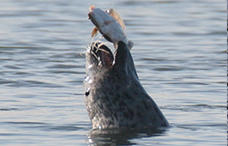The Context
Scotland’s Seal Populations
Scotland is home two seal species, the grey seal (Halichoerus grypus) and the common, or harbour, seal (Phoca vitulina). Populations of both species are of international importance with 40% of the world population of grey seals found in Britain and over 90% of British grey seals breeding in Scotland, the majority in the Hebrides and in Orkney. Like other marine mammals, seals are under threat from climate change, toxic pollution, commercial over-fishing, entanglement in fishing gear, ship-strikes, disturbance and habitat loss. The collective impact of these growing threats on our seal population is unknown, but we know that common seal numbers are in serious decline.
- Total UK grey seal population at the start of the 2010 breeding season, is estimated to have been 112,300. Around 88% of these breed on Scottish beaches, with the largest colonies in the Outer Hebrides and Orkney
- Harbour (or common) seal numbers in the UK are estimated at around 37,300, 79% of which were counted at Scottish haul-out sites
- Grey seal numbers in the UK have been increasing for several decades, though there are now clear signs of a slowing down of population growth. Almost all continued population growth is occurring at North Sea sites, especially those in England
- Harbour seals present an immediate conservation concern, as serious declines have recently been documented in harbour seal populations around Scotland
- Between 2000 and 2012 numbers of harbour seals in Orkney declined by 75%, in Shetland by 30%, and in the Firth of Tay by 85%. In the Moray Firth numbers declined by 45% and in the Outer Hebrides by 36% between 2000 and 2010, but are now stable. In the Inner Hebrides and Scottish West coast numbers have remained stable
- Both grey and common seals are protected species under EU and domestic laws and the UK and Scottish Governments are required to ensure their favourable conservation status
For further information visit: www.smru.st-andrews.ac.uk
The Salmon Farming Industry in Scotland
- Scotland is currently the largest producer of farmed Atlantic salmon in the EU and third largest globally - producing 162,223 tonnes in 2012, with an estimated value of £537 million at farm gate prices and accounting for over one-third by value of Scotland's food exports
- Salmon farming in Scotland directly employs over 2,000 people with many more thousands of jobs in the salmon supply chain. The industry has injected over £1.4 billion into suppliers and services during the last four years and has invested over £205 million in capital projects over the last five years. The vast majority of this has been in remote, rural communities in the Highlands and Islands
For further information please visit: www.scottishsalmon.co.uk and www.scotland.gov.uk.
The Importance of Seals both to the Scottish Economy and the Public
Seals are very popular animals and nature tourism is a rapidly growing industry in Scotland providing a valuable and sustainable income for many coastal communities. Seals are frequently used as iconic animals in advertising and promotions for Scottish tourism, and common seals featured as one of the Big Five species identified by SNH for the Scottish Government’s ‘Year of Natural Scotland’ in 2013. Scottish Natural Heritage and the Scottish Government have both recently commissioned reports into the economic benefits of nature-based and wildlife tourism in Scotland. Please see: www.snh.gov.uk and www.scotland.gov.uk.
These reports concluded:
- The net annual economic impact of wildlife tourism was estimated at £65 million, with 2,763 full time Equivalent jobs in existence because of the activities of wildlife tourism in Scotland
- In total, 1.12 million trips are made each year to or within Scotland for the primary purpose of viewing wildlife. 56% of these trips are made by domestic (UK) tourists. £276 million is spent on these trips, with 75% spent by domestic tourists
- With 0.63 million domestic tourism trips, 5.2% of all domestic tourism trips to Scotland are being primarily motivated by wildlife. 6.3% of domestic tourism nights and 7.4% of domestic tourism expenditure in Scotland is primarily motivated by wildlife
- In addition, 0.41 million trips are made by wildlife day visitors, with £14 million of expenditure
It is clear that seals are a popular and highly visible attraction for wildlife tourism and even if shooting were no threat to seals numbers, it still has the potential to negatively impact upon tourism. A recent newspaper report demonstrates an example of how seal shooting can deter tourists: www.heraldscotland.com.
Welfare, conservation and ethical concerns
- The shooting of seals raises serious welfare and ethical concerns, with a significant strand of public opinion opposing shooting, not least when alternative non-lethal means of resolving conflicts are available
- The shooting of common seals is undesirable given the significant decline in UK populations
- Inevitably shooting will result in some proportion of animals that are not killed instantly, which is a significant animal welfare concern
- The shooting of seals in the breeding seasons can lead to starvation of dependent pups
- Seal depredation is one of the most frequent causes of farmed salmon escaping into the wild
- Current powerful acoustic deterrent devices (ADDs) can cause irrevocable hearing damage to seals and can disturb other marine life, but effective yet less powerful ADDs are also now available


